Create a Poll in Microsoft Teams: Step-by-Step Guide
September 17, 2024
September 17, 2024
June 12, 2025
June 12, 2025
Creating a poll in Microsoft Teams is a great way to quickly gather feedback from your team. Whether it's for a project decision or a simple survey, setting up a poll is straightforward. Follow these steps to add your own poll to your Teams channel or chat. For more insights into Microsoft Teams, check out these related articles: Top Microsoft Teams Alternatives in 2024, ChatGPT for MS Teams: How to Generate Meeting Notes, and Zoom vs Microsoft Teams: Pros and Cons for Businesses.
How to Create a Poll in Microsoft Teams
Step 1: Accessing the Teams Channel or Chat
First, open Microsoft Teams and navigate to the channel or chat where you want to create the poll. This is important because the poll will only be visible to members of that specific channel or chat.
- Navigate to the desired channel or chat: Use the left sidebar to find and click on the correct team and channel.
- Importance of selecting the right group conversation: Ensure that the poll reaches the right audience. For example, if the poll is about a project, post it in the project-specific channel.
Step 2: Adding the New Poll via Microsoft Forms
Microsoft Forms is the tool used to create a real-time poll in Teams. Here's how to access it:
- Access Microsoft Forms from the Teams interface: At the bottom of your Teams window, look for the Forms icon. If it's not visible, use Messaging Extensions.

Image from Microsoft
- Using Messaging Extensions if the Forms icon isn’t visible: Click on the three dots (...) below the message box, then select "Forms" from the list of available apps.
Step 3: Crafting Your Poll Questions and Options
Writing clear and concise poll questions is key to getting useful feedback. Follow these guidelines:
- Guidelines for writing clear and concise poll questions: Make your question specific and easy to understand. Avoid jargon and ambiguous words.
- Adding and managing multiple answer options: Provide clear choices for answers. You can add up to 10 options, ensuring they cover all possible responses.
Step 4: Customizing Poll Settings
Customize your poll to fit your needs by exploring more form settings:
- Enabling multiple answers and anonymous responses: Toggle the options to allow multiple choice if needed and to keep responses anonymous for honest feedback.
- Options for sharing results automatically: Decide if results should be shared with participants automatically after they vote.
Step 5: Saving and Posting Your Poll
Before posting, ensure everything is perfect:
- Previewing and editing your poll before posting: Click "Preview" to see how your poll will look. Make any necessary edits.
- Sending the poll to the channel or chat: Once satisfied, click "Send" to post your poll in the chosen channel or chat. Recipients vote directly.
Following these steps will help you create an effective poll in Microsoft Teams.
Monitoring and Analyzing Poll Results in Microsoft Teams
Once your poll is live, you need to keep an eye on the results to make informed decisions. Microsoft Teams makes this easy with real-time tracking and detailed statistics.
Real-Time Results Tracking Within the Teams Chat

As soon as participants start voting, you can see the results immediately in the chat or channel where the poll was posted. This real-time tracking is crucial for making quick decisions and understanding the team's sentiment.
- Instant Feedback: See how many people have voted and what the current standings are.
- Immediate Adjustments: If the poll reveals unexpected results, you can quickly address any issues or misunderstandings.
Viewing Detailed Responses and Statistics
To get a deeper understanding of the poll results, you need to look at the detailed responses and statistics. Microsoft Teams provides tools for this.
- Detailed Breakdown: Click on the poll to view each participant's response. This helps identify trends and outliers.
- Statistical Analysis: Use the provided charts and graphs to analyze the data. Look for patterns that can inform future decisions.

Image from Think Outside the Slide
Using Poll Results to Inform Team Decisions
Polls are only useful if you act on the results. Use the data gathered to make informed decisions that benefit the team.
- Data-Driven Decisions: Base your choices on the poll data rather than assumptions. This ensures that the team's voice is heard.
- Actionable Insights: Identify key takeaways from the poll results. For example, if a majority prefers a particular project approach, consider implementing it.
Sharing and Discussing Results with Team Members
Communication is key to effective teamwork. Share the poll results with your team and discuss them to ensure everyone is on the same page.
- Transparent Sharing: Post the poll results in the channel or chat so everyone can see them.
- Open Discussion: Encourage team members to discuss the results. This can provide additional insights and foster a collaborative environment.
By effectively monitoring and analyzing poll results in Microsoft Teams, you can make more informed decisions and improve team collaboration.
Common Issues and Solutions When Creating Polls in Microsoft Teams
Creating polls in Microsoft Teams can sometimes be tricky. Here are common problems and how to solve them.
Troubleshooting the Absence of the Forms Icon
If the Forms icon is missing, you can't create polls easily. Here's what to do:
- Check Messaging Extensions: Click on the ellipsis (...) below the message box. Look for "Forms" there.
- Search for Forms: Use the search bar to find the Forms app in Teams.
- Add Forms Manually: Go to the Teams app store, search for Forms, and add it to your app list.
Addressing Problems with Poll Submission and Response Collection
Participants might face issues submitting their responses. Here's how to address this:
- Check Internet Connection: Ensure participants have a stable internet connection.
- Update Teams: Make sure everyone is using the latest version of Microsoft Teams.
- Clear Cache: Ask participants to clear their Teams cache if they continue to experience issues.
Ensuring Poll Functionality in Different Microsoft Teams Environments
Polls might not work the same in all Teams environments. Here's how to ensure functionality:
- GCC High and DoD Environments: Note that some features, like certain poll types, may not be available in these environments. Check official Microsoft documentation for updates.
- Mobile vs. Desktop: Make sure that the poll settings are compatible with both mobile and desktop versions of Teams. Some features might be limited on mobile.
- Cross-Platform Issues: If participants use different platforms (web, desktop, mobile), ensure that the poll settings are universally accessible.
By understanding and addressing these common issues, you can create more effective and accessible polls in Microsoft Teams.
{{rt_cta_ai-convenience}}
How Tactiq Enhances Your Microsoft Teams Meetings

Tactiq is an AI-powered tool that enhances your Microsoft Teams experience by providing real-time transcriptions, AI summaries, and customizable prompts. Here's how it helps with your virtual meetings:
- Real-Time Transcription: Tactiq transcribes meetings live, allowing you to focus on the discussion while effortlessly crafting relevant poll questions.
- Summarizing Poll Data: Tactiq generates AI-powered summaries, making it easy to review and analyze poll outcomes after the meeting.
- AI Meeting Kits and Prompts: Use AI meeting kits and custom prompts to automate poll creation, follow-up actions, and meeting insights.
- Organized Poll Results: It neatly organizes poll data for easy sharing and discussion with the team.
With Tactiq, you can streamline every step of the meeting process in Microsoft Teams, from setup to actionable insights. Download the free Tactiq Chrome Extension today!
Best Practices for Creating Effective Polls in Microsoft Teams
Creating effective polls in Microsoft Teams involves several key steps. Follow these best practices to ensure your polls are clear, engaging, and useful.
Crafting Clear and Purposeful Poll Questions
1. Be Specific and Direct: Write questions that are straightforward and easy to understand. Avoid using jargon or complex language. For example, instead of asking, “What are your thoughts on the new project management software?” ask, “Do you find the new project management software easy to use?”
2. Focus on One Topic: Each poll should address a single topic. This keeps it focused and ensures that responses are relevant. Mixing multiple topics in one poll question can confuse participants.
Engaging Team Members with Relevant and Timely Polls
1. Choose the Right Timing: Post polls when team members are most likely to respond. Avoid busy times like the end of the day or during heavy workload periods. Lunchtime or mid-morning might be ideal.
2. Make Polls Relevant: Ensure that the poll questions are related to current projects or discussions. This increases the likelihood that team members will see the value in participating.
Ensuring Anonymity and Confidentiality When Needed
1. Use Anonymity for Sensitive Topics: If the poll involves sensitive issues, enable the option for anonymous responses. This encourages honest feedback without fear of reprisal.
2. Communicate Privacy Policies: Let team members know how their responses will be used and protected. Transparency builds trust and encourages participation.
Analyzing and Acting on Poll Results to Improve Team Collaboration
1. Review Results Promptly: Analyze poll results as soon as possible to keep the momentum going. Delays can cause participants to lose interest.
2. Share Insights with the Team: Present the findings to the team and discuss the implications. This ensures everyone is on the same page and understands the impact of their input.
3. Take Action Based on Feedback: Implement changes or make decisions based on the poll results. Showing that responses lead to tangible actions increases future engagement.
Following these best practices will help you create effective and meaningful polls in Microsoft Teams, fostering better communication and decision-making within your team.
To create a poll, open the desired Teams channel or chat, click the Forms icon (or find it via Messaging Extensions), craft your question and options, customize settings, preview, and then send it. This lets you quickly gather feedback from the right group so you can make informed decisions faster.
If the Forms icon isn’t visible, click the three dots below the message box to access Messaging Extensions, search for 'Forms,' or add it manually from the Teams app store. This ensures you can still create polls without interruption, keeping your workflow smooth.
Write specific, direct questions focused on a single topic and avoid jargon or complex language. Clear questions help your team respond accurately, so you get actionable insights that drive better decisions.
Tactiq provides real-time meeting transcriptions, AI-powered summaries, and organizes poll data for easy sharing and discussion. You save time and gain deeper insights, making it easier to act on poll results and improve team collaboration.
Review poll results promptly, share insights with your team, and take action based on the feedback. Acting quickly and transparently shows your team their input matters, boosting engagement and trust for future polls.
Want the convenience of AI summaries?
Try Tactiq for your upcoming meeting.
Want the convenience of AI summaries?
Try Tactiq for your upcoming meeting.
Want the convenience of AI summaries?
Try Tactiq for your upcoming meeting.









